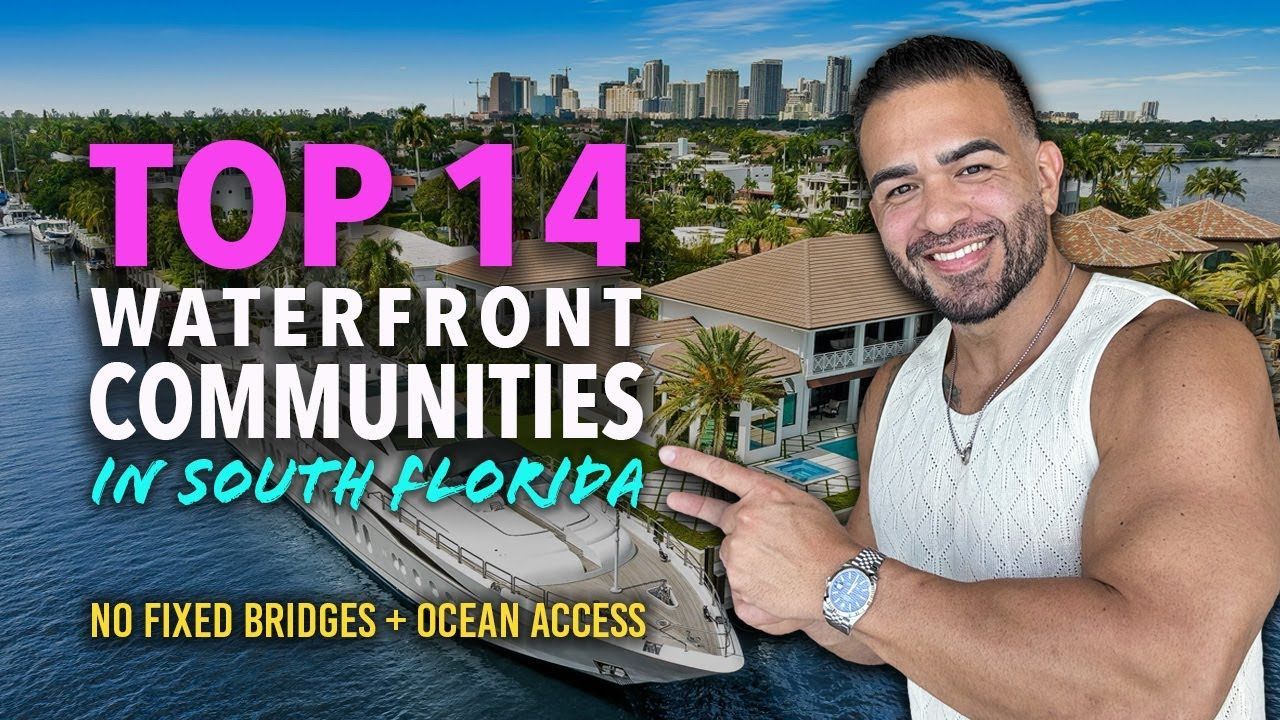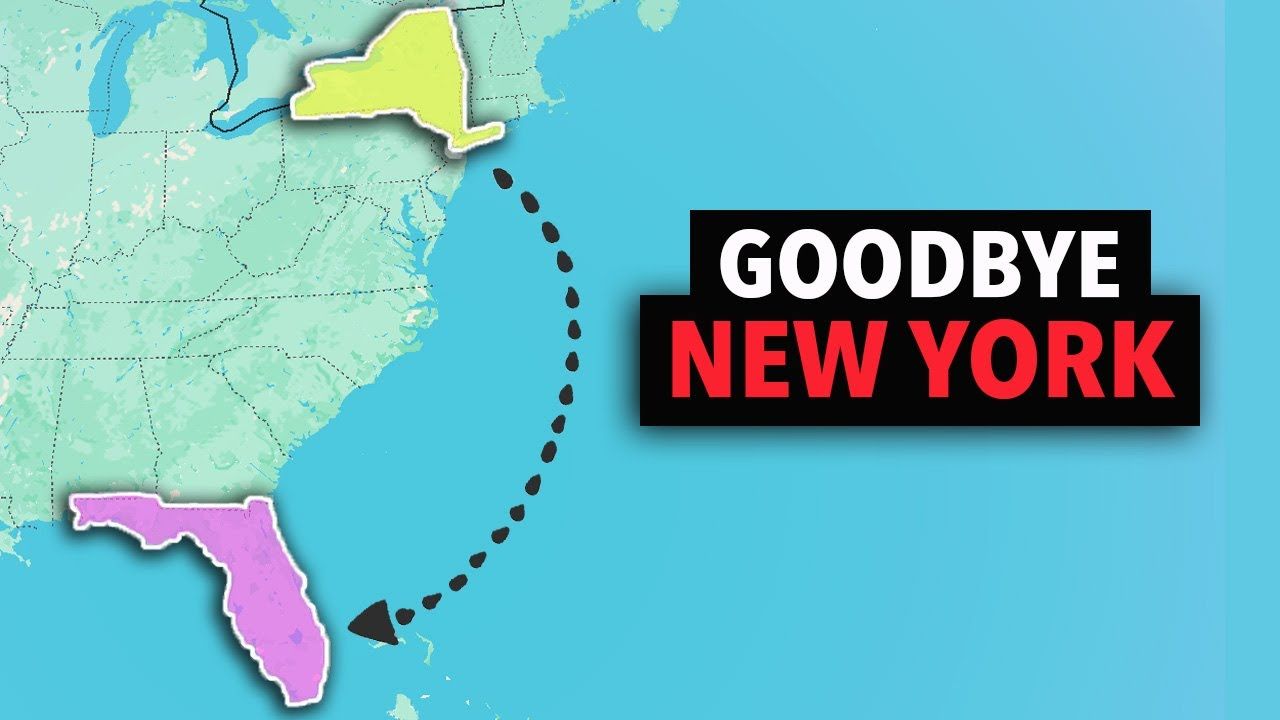6 More Reasons NOT to Move to Florida (THAT AREN'T OBVIOUS!)
If you are seriously considering moving to Florida, this is the article to read before you sign a lease or write an offer. Having lived in the Sunshine State for over 30 years, I love Florida, but I also want to give you the honest local perspective on things most people do not talk about until after they arrive. If you are moving to Florida, these six lesser-known negatives deserve your attention so you can make a smart, informed decision and avoid surprises that could become costly or even harmful to your health.
Table of Contents
- Outline
- Introduction - Why I Wrote This
- 1) Red Tide - the beach dream with a nasty catch
- 2) Allergies and Mold - the sneaky, year-round irritants
- 3) Bugs - more than you expect
- 4) Auto insurance - prepare for high premiums
- 5) White-collar crime and wire fraud - not the headline you expected
- 6) Rising sea level - long-term risk to coastal property values
- Practical checklist if you are moving to Florida
- Conclusion - balancing the positives and negatives
- Frequently Asked Questions About Moving to Florida
Introduction
Move to Florida and you will get sunshine, beaches, no state income tax, and a huge lifestyle shift from the North, West, or Midwest. That is the draw for thousands every year. But the reality is that Florida is not paradise 24-7. If you are moving to Florida, you should know the things that can ruin a beach day, send your allergy meds sky high, or create unexpected expenses on insurance and maintenance.
Throughout this article I will explain each issue, give real-life context, share relevant stats, and offer practical steps you can take if you decide to relocate. I will also include screenshots tied to specific moments so you can visualize the points I'm making.
1) Red Tide - the beach dream with a nasty catch
One of the most heartbreaking things for newcomers is arriving excited for beach life, only to find the shore closed because of red tide. Red tide is caused by the algae Karenia Brevis. When this algae blooms, it colors the water a red-brown hue and creates toxins that kill fish and sickens marine mammals. The smell of decaying fish along the coast is something you will not forget.

Where and when does red tide occur? It is most frequent on Florida's west coast - think Clearwater down to Sanibel Island - and it shows up most often in late summer and fall. But it is not strictly local: red tide can travel and affect large areas of the Gulf and even reach the Florida Keys. Some blooms last a few days, others spread hundreds of square miles and can persist for three to five months. There are documented cases where algae pockets reappear sporadically for up to 18 months and cover thousands of square miles.
Health impacts matter. Red tide releases airborne toxins that can worsen respiratory conditions, cause eye irritation, and make beach-going unpleasant at best. If you are moving to Florida and have asthma or other breathing issues, red tide is an important factor when choosing which coast or county to call home.
- Tip: If you want to reduce your chances of dealing with red tide, the Atlantic east coast (Miami, Fort Lauderdale) tends to see it less frequently than the Gulf west coast.
- Tip: Monitor local environmental alerts and NOAA updates during late summer and fall.
2) Allergies and Mold - the sneaky, year-round irritants
If you grew up in a place with clear allergy seasons, Florida will change your expectations. For many residents, allergy season in Florida can feel like it never ends. Tree pollen season alone can last five to six months - beginning as early as late December and stretching into May. Some people experience symptoms from February to September.
Common Florida allergens include flower pollen, grass pollen, tree pollen, ragweed, dust, mold, animal dander, and insect bite reactions. According to Allergy Capitals reporting, several Florida metro areas rank among the hardest places to live with pollen allergies. Cities like Sarasota, Cape Coral, Orlando, Miami, Palm Bay, and Tampa are frequently on the list.
Which trees cause the most trouble? Not always the showy flowering trees. In Florida the culprits include pine trees, American elms, bayberry, bluejack oaks, maples (one of the first to pollinate), and river birch. Your neighborhood mix of trees will influence the severity of your symptoms.
Then there is Saharan dust - a surprising global phenomenon. During late June through mid-August, fine dust from the Sahara can be transported across the Atlantic and affect air quality in Florida. These tiny particles irritate lungs and airways and can make asthma and bronchitis worse.
Mold is another big deal because Florida is humid. We are one of the most humid states in the U.S. and that means constant moisture, heavy rainfall, storms, and frequent flooding in some areas. Mold finds this humid environment welcoming. Estimates suggest over 50 percent of homes in Florida show visible mold growth and more than 85 percent have at least one type of mold present in the air. Not all mold is dangerous, but certain types such as Stachybotrys chartarum - commonly called black mold - can produce toxins that cause allergic reactions, respiratory problems, headaches, and worse.
Insurance and disaster aid also reflect mold risk. Florida had the highest number of mold claims in the U.S., with 10,617 claims reported in 2019 representing about 24.7 percent of the national total. FEMA expanded disaster aid programs to include mold growth after major storms, and billions in damage have been linked to water intrusion and subsequent mold issues, especially after hurricanes like Ian in 2022.
- If you are moving to Florida and are mold-sensitive: Get a mold inspection before you buy. Understand that some mold findings are common and manageable. If you are severely immune-compromised or react badly to minimal mold, consider a less humid state.
- If you are moving to Florida and not super-sensitive: Preventative maintenance is key. Regular inspections, fixing leaks fast, running dehumidifiers, and good ventilation will reduce risk.
3) Bugs - more than you expect
Bugs in Florida are famous, and many newcomers are surprised by the variety and persistence. Beyond mosquitoes and cockroaches, there are insects you might not have seen elsewhere that become seasonal nuisances.
Lovebugs
Lovebugs are small black flies with a red spot on the thorax. They are named for their mating behavior - often flying in attached pairs. Lovebug swarms are most common in spring and fall. They do not bite, but they can coat windshields and vehicle grilles, obstruct visibility, and ruin paint if not cleaned quickly because their bodies are acidic after decomposition.

To reduce the impact of lovebugs, keep grills and windshields clean, use high-pressure washing on vehicles, and reduce outdoor lighting at night which attracts flying insects.
Midges - Noseeums
Midges, also called noseeums or sand flies, are tiny biting flies common near beaches, marshes, wetlands, and lakes. They are most active in humid and rainy conditions during summer and fall. Their bites are notoriously itchy and can leave red welts. They are attracted to carbon dioxide, so people and pets are prime targets.
Prevention includes wearing long sleeves and pants at dawn and dusk, using insect repellent, and installing fine mesh screens on windows and doors. If you have a lake or marsh behind your house, expect more activity during peak times.
Termites - the silent property eaters
Florida is number one in the U.S. for termite problems. Subterranean, drywood, and dampwood termites are all present, but subterranean types are the most common threat. They tunnel through soil and enter homes through tiny cracks, eating wood and compromising structural integrity.
Signs of termites include discarded wings, mud tubes along foundations, and hollow-sounding wood. Regular professional inspections and preventative measures - such as keeping wood away from soil contact and treating exterior wood - are essential. If you are moving to Florida and buying an older home, expect that termite inspections will be part of the purchase process.
Termites and Financing
Termites do not just threaten the physical structure of a home - they complicate financing and insurance. Most lenders require termite inspections before closing. If damage or active infestation is found, lenders may require treatment and repairs before approving the loan. Homeowners insurance often excludes termite damage, so coverage gaps exist.
If you are using FHA or VA financing, specific rules apply. FHA loans require licensed pest control inspections and remediation when termite activity is present. VA loans often require a wood destroying insect report. Treatment can be expensive, sometimes requiring tent fumigation for drywood termites or costly localized treatments. If you are moving to Florida and planning to finance, budget for potential termite treatment costs and make sure your real estate agent understands how to negotiate repairs or price adjustments if infestations are discovered.
- Tip: Ask sellers for recent pest control reports before making an offer.
- Tip: Include a termite/pest contingency in your purchase contract.
4) Auto insurance - prepare for high premiums
Florida leads the nation in auto insurance costs for several reasons. If you are moving to Florida from a state with lower rates, expect sticker shock when shopping for coverage.

Key reasons for high premiums in Florida:
- High rate of uninsured or underinsured drivers - in 2019 about 20.4 percent of Florida drivers were uninsured, which is the highest in the nation.
- No-fault insurance system - Florida requires personal injury protection (PIP) that pays medical and related expenses regardless of fault. This system is prone to fraud and exaggerated claims.
- Natural disaster exposure - hurricanes and flooding increase the risk profile for vehicles, especially in coastal and low-lying areas.
- High population density - more drivers, tourists, college students, and elderly motorists increase accident risk.
Insurance companies build these risks into premiums. If you are moving to Florida, shop carefully, compare providers, and ask about discounts for safe driving, bundling home and auto, and anti-theft devices. Be aware that certain rates are also influenced by your ZIP code.
5) White-collar crime and wire fraud - not the headline you expected
You might think white-collar crime is a concern only in financial hubs, but Florida has among the highest per capita rates. The FBI reported over 33,000 incidents of white-collar crime in 2020 - a trend that includes identity theft, wire fraud, occupational fraud, embezzlement, and other financial schemes.
Wire fraud is particularly relevant to real estate transactions. Criminals intercept and change wiring instructions, causing buyers or sellers to wire funds to fraudulent accounts. In one FBI study Florida ranked third for wire fraud incidents, with large dollar losses from victims. Real estate professionals and buyers need to be vigilant:
- Always confirm wiring instructions by calling a trusted number you already have on file. Do not rely on email alone.
- Be suspicious of last-minute changes to wire details and verify through multiple channels.
- Use secure portals and consider using attorney-hold funds or escrow services for transfers when possible.
Occupational fraud also bites local businesses. The median loss for occupational fraud is about $150,000 and it typically takes over a year to detect. For small businesses, fraud can be catastrophic - roughly 20 percent of small businesses that are victims of fraud end up bankrupt.
6) Rising sea level - long-term risk to coastal property values
Sea level rise is not an abstract concern in Florida; it is a real, measurable trend. According to NOAA data, sea levels in Florida have risen about eight inches since 1950. Many scientists expect acceleration, with projections that could reach roughly two feet by 2060 depending on global emission scenarios.
Real estate implications are serious. Homes in low-lying areas face higher flood risk, more frequent storm damage, and potential long-term depreciation. One study estimated Florida properties in flood-prone zones lost about $5.4 billion in value since 2005. Insurance companies are reacting by increasing premiums or refusing to cover properties in the riskiest zones, making it more expensive to own coastal real estate.

The tragic Surfside Champlain Tower collapse sparked discussion about how saltwater intrusion and rising groundwater can corrode concrete and steel reinforcements in coastal structures over time. Salt accelerates corrosion, which in turn weakens structural elements. This is a valid concern for older beachfront buildings and for investors thinking long term.
- Tip: If you are moving to Florida and are considering a coastal condo or older structure, get specialized inspections focused on water intrusion and concrete corrosion.
- Tip: Consider elevation, flood maps, and long-term insurance availability when choosing a neighborhood.
Practical checklist if you are moving to Florida
Here is a short checklist to help you prepare and avoid unpleasant surprises when moving to Florida.
- Research specific neighborhoods for red tide history, flood risk, and elevation.
- Get a mold inspection if you have severe sensitivity; otherwise insist on a comprehensive home inspection that looks for leak-prone areas.
- Schedule an annual pest control plan and termite inspection. Factor termite treatment costs into your budget.
- Shop multiple auto insurance carriers and learn the PIP rules in Florida. Consider higher liability limits if uninsured drivers are common in your area.
- Be vigilant about wire transfer verification for any real estate transaction. Call your title company and escrow officer using known phone numbers.
- Check historical hurricane and flood claims for the area. Ask neighbors and the HOA about past storm damage and mold remediation.
- Understand local allergy calendars and consider HVAC upgrades and HEPA filters to help with pollen and dust.
Conclusion - balancing the positives and negatives
There are plenty of reasons people keep moving to Florida - weather, beaches, lower taxes, and lifestyle. If you are moving to Florida, it is essential to weigh these positives against the lesser-known negatives I covered: red tide, long allergy seasons, mold risk, seasonal swarms of insects like lovebugs and midges, termite pressure, high auto insurance costs, white-collar crime risks, and the long-term threat of rising sea levels.
For many people, the benefits outweigh these downsides, especially if you plan wisely and choose the right location. For others, particularly those with severe allergies or mold sensitivity, or people who cannot manage the financial risks from termites and insurance, Florida might not be the best fit.
If you are moving to Florida, prepare, ask questions, and use inspections and specialists to make a confident decision. The right information up front can save you headaches, health issues, and money down the line.
Frequently Asked Questions About Moving to Florida
What is red tide and where does it occur in Florida?
Red tide is an algae bloom caused by Karenia brevis that discolors water and releases toxins harmful to marine life and people. It most often affects the west coast of Florida - from Clearwater to Sanibel - during late summer and fall but can show up elsewhere depending on currents and conditions.
Are allergies worse in Florida than other states?
Many people experience longer and more intense allergy seasons in Florida due to extended tree pollen seasons, a variety of allergenic plants, and factors like mold and Saharan dust. Several Florida cities rank among the hardest places to live for pollen allergies.
How common is mold in Florida homes and what should buyers do?
Mold is common because of Florida's humidity and rainfall. Over 50 percent of homes show visible mold in some surveys, and mold-related insurance claims are high. Buyers should get comprehensive inspections, fix sources of water intrusion, and maintain good ventilation and humidity control.
What bugs should I expect if I move to Florida?
Expect mosquitoes, lovebugs during mating seasons, midges or noseeums near water, and termite pressure year-round. Use screens, repellents, and professional pest control to manage the nuisances.
Do termites affect mortgage approval in Florida?
Yes. Many lenders require termite inspections, and if damage or active infestation is found they may require remediation before approving loans. FHA and VA loans have specific pest-related requirements as well.
Why is auto insurance so high in Florida?
High rates stem from a large percentage of uninsured drivers, a no-fault PIP system prone to fraud, frequent hurricanes and flooding risk, and dense traffic in major metro areas. All of these increase cost for insurers, who pass it on to drivers.
Is Florida safe from financial scams and wire fraud?
Florida ranks high in white-collar crime incidents and wire fraud related to real estate. Buyers and sellers should verify wiring instructions by phone, use secure escrow accounts, and be wary of unsolicited emails changing payment details.
Should I worry about sea level rise when buying property in Florida?
Yes. Sea levels have risen and are projected to continue rising. Low-elevation coastal properties face increased flood risk, higher insurance costs, and potential loss of value. Consider elevation, flood insurance availability, and long-term resilience measures.

Jonathan Alexander creates educational YouTube content to guide potential buyers through the process of relocating to South Florida, offering insights on the best places to live and what to expect. As a seasoned Realtor®, he combines his expertise with a passion for helping clients make informed real estate decisions.















